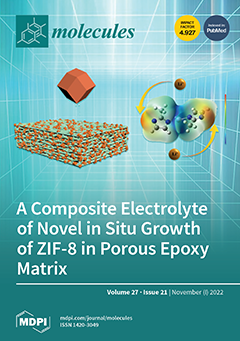Twenty-two flavonoids were isolated from the leaves and stems of
Sedum japonicum subsp.
oryzifolium (Crassulaceae). Of these compounds, five flavonoids were reported in nature for the first time, and identified as herbacetin 3-
O-xyloside-8-
O-glucoside, herbacetin 3-
O-glucoside-8-
O-(2′′′-acetylxyloside), gossypetin 3-
O-glucoside-8-
O-arabinoside, gossypetin 3-
O-glucoside-8-
O-(2′′′-acetylxyloside) and hibiscetin 3-
O-glucoside-8-
O-arabinoside via UV, HR-MS, LC-MS, acid hydrolysis and NMR. Other seventeen known flavonoids were identified as herbacetin 3-
O-glucoside-8-
O-arabinoside, herbacetin 3-
O-glucoside-8-
O-xyloside, gossypetin 3-
O-glucoside-8-
O-xyloside, quercetin, quercetin 3-
O-glucoside, quercetin 3-
O-xylosyl-(1→2)-rhamnoside-7-
O-rhamnoside, quercetin 3-
O-rhamnoside-7-
O-glucoside, kaempferol, kaempferol 3-
O-glucoside, kaempferol 7-
O-rhamnoside, kaempferol 3,7-di-
O-rhamnoside, kaempferol 3-
O-glucoside-7-
O-rhamnoside, kaempferol 3-
O-glucosyl-(1→2)-rhamnoside-7-
O-rhamnoside, kaempferol 3-
O-xylosyl-(1→2)-rhamnoside, kaempferol 3-
O-xylosyl-(1→2)-rhamnoside-7-
O-rhamnoside, myricetin 3-
O-glucoside and cyanidin 3-
O-glucoside. Some flavonol 3,8-di-
O-glycosides were found in
Sedum japonicum subsp.
oryzifolium as major flavonoids in this survey. They were presumed to be the diagnostic flavonoids in the species. Flavonoids were reported from
S. japonicum for the first time.
Full article






